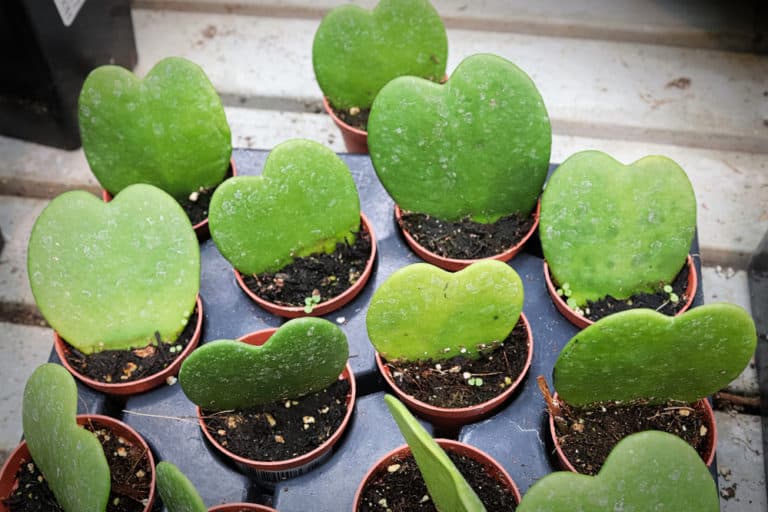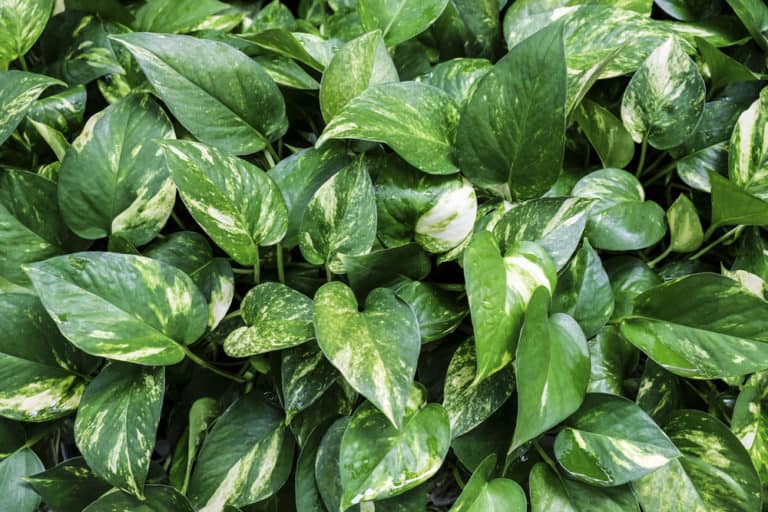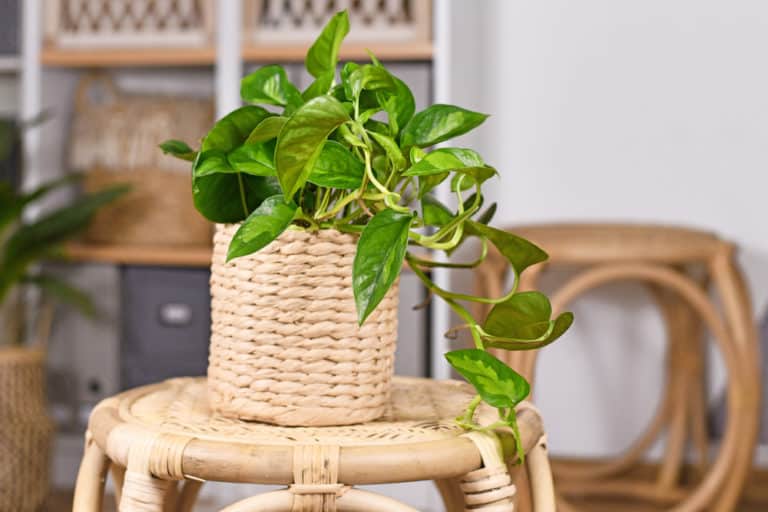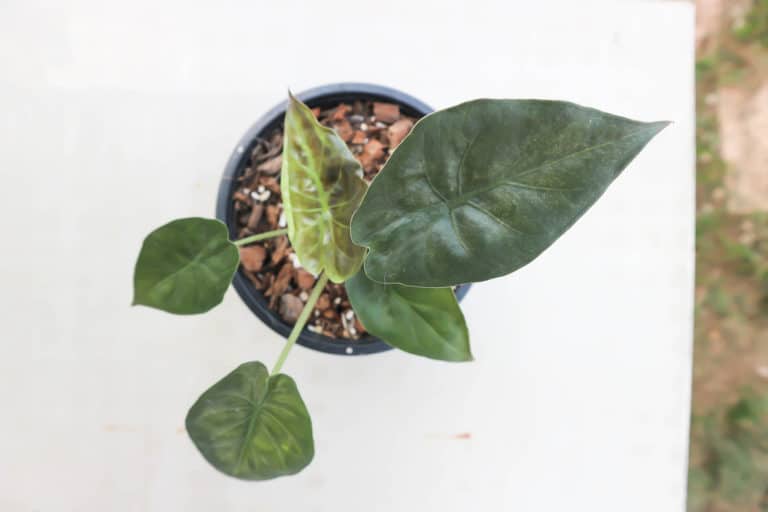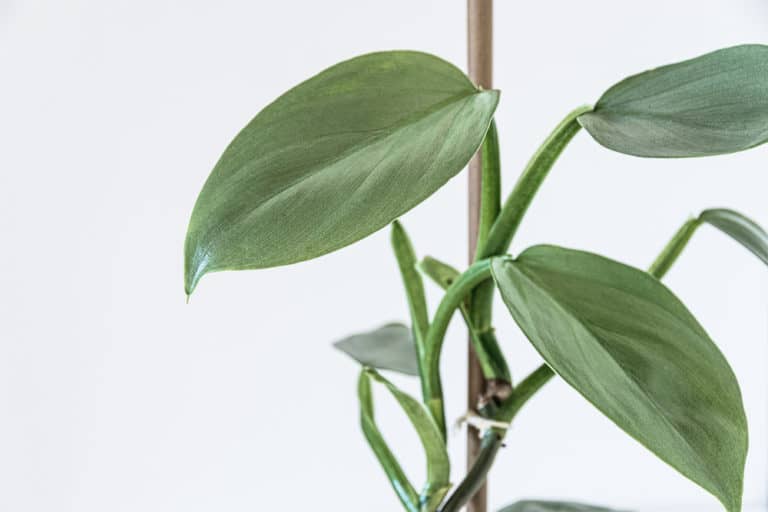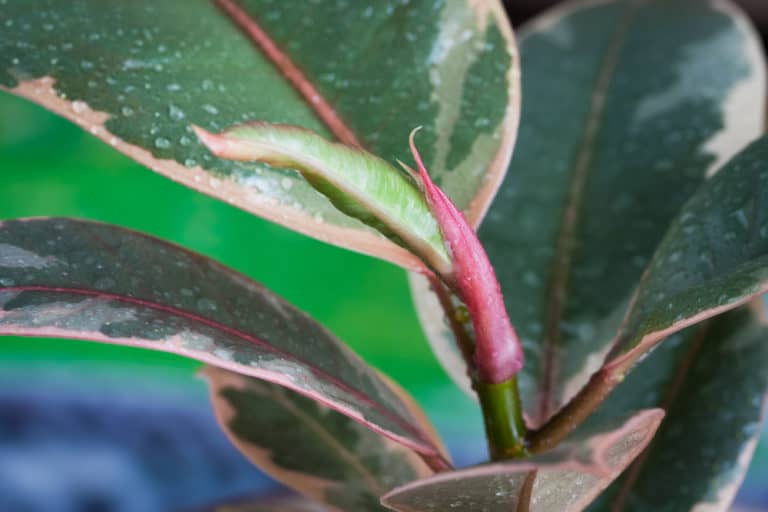Monstera Deliciosa ‘Albo Variegata’ Care Guide (2024)
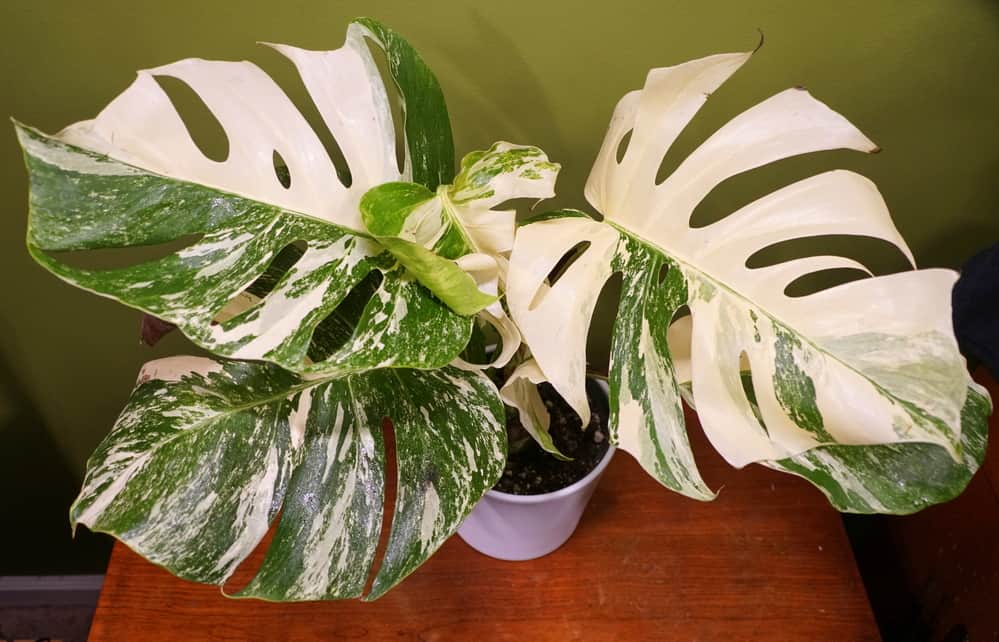
I remember stopping by a plant shop and seeing this majestic specimen with broad painted leaves as if it was splashed with creamy white paint. I remember standing in awe of the Monstera deliciosa ’Albo Variegata’ which is commonly referred to as Monstera Albo, and was not surprised by how it was priced due to its insane form and rarity.
| Scientific Name | Monstera deliciosa ‘Albo-Variegata’ |
| Common Name | Monstera Albo, Swiss Cheese Plant, Windowleaf |
| Light | Bright indirect sunlight |
| Watering | Weekly, water if the top half of the soil feels dry |
| Temperature | 65°F and 80°F (18°C – 27°C) |
| Hardiness Zone | USDA Hardiness zone 9b to 11 |
| Humidity | 70-85% |
| Soil Type | Rich, quick-draining, loamy |
| Soil pH | 5.5-7.0 (acidic to neutral) |
| Fertilizing | Balanced fertilizer ratio applied once a month |
| Repotting | When the roots begin growing out of the pot |
| Pruning | When the leaves revert to green or when infected |
| Propagation | Stem cuttings |
| Toxicity | Toxic to humans and pets |
| Mature Size | 25 to 90 cm or 10’’ to 32’’ long and 30 cm wide |
| Bloom Time | Varies with the season |
What’s Unique About Monstera Albo?
The Monstera albo plant is a subspecies of the Monstera deliciosa and is becoming one of the hottest plants being sold on the market. With its stunning set of foliage having generous variegation, one would not be able to resist the flowering plant’s charm!
The Monstera albo plants are of tropical descent and are native to Central and South America. Characterized by the heavy variegation and large, glossy heart-shaped leaves, no wonder it’s becoming a highly coveted ornamental plant.
The creamy stripes do not contain chlorophyll as would normal green leaves. These portions do not undergo photosynthesis, but these should not hinder the plant from getting lots of sun and love!
Monstera Albo Care
The Monstera Albo plant care involves giving the plant adequate light, sufficient watering, and a warm, humid environment. While the plant may actually be a bit hardy, it won’t hurt giving the plant more attention than it requires. Below are some of the practical guides that will help you with Monstera Albo Variegata care.
Light
To meet the Monstera Albo light requirements, place the plant in an east-facing window where it can receive an ample amount of filtered light.
You can also have the plant grow near a bright window as long as there’s a curtain to act as a filter when the light becomes too intense. It’s important to choose a strategic location so that the sun doesn’t shine directly on the leaves.
The trick with Monstera Albo Variegata light needs is avoiding full sun exposure. When grown outside, make sure that the plant will also receive some afternoon shade, this will prevent leaf scorching and other damage to the foliage.
Watering
Being a little hardy than most ornamental plants with massive leaves, the Monstera Albo watering is typically done when the top inch of the soil dries out. Note that this tropical beauty will do much better in drier soil than in wet soggy medium.
Avoid overwatering at all costs and water the Albo plant thoroughly but not frequently. Overwatering can cause root rot and may damage the root system over time. This is in fact the leading cause of wilting and premature senescence of the leaves.
Pro tip: Always check the soil’s wetness first as this will determine the watering needs of the plant.
Temperature
As you may guess, the plant thrives in warm temperatures, hence the Monstera Albo temperature range is between 65°F and 80°F (18°C – 27°C). The plant barely possesses a low-temperature tolerance and so in order to attain the ideal temperature for Albo plant, do not let them stand in the cold draft – or even near hot air.
Note that monstera albo only thrives at USDA hardiness zone 9b to 11. When grown outside, you should immediately bring the plant in during winter to avoid exposure to extreme cold, as this can damage the plant which can affect foliage growth and development.
Humidity
Considering the tropical environment from which the plant originates, you can expect that the Monstera Albo humidity requirements are quite high.
If grown as an ornamental houseplant, you can adjust the current humidity level at home (where humidity often drops up to 20%) by using a humidifier or setting up a pebble stray.
The ideal humidity for variegated Monstera Albo is between 70-85 %, but they can be flexible and may do just fine with normal household humidity. However, regular misting here and there is a good practice to mimic the humid condition that will help your plant remain vibrant and healthy.
Soil
Most variegated monstera prefer a well-draining and rich soil mix. You can create the proper soil for Monstera Albo Variegata by mixing an equal proportion of peat moss for OM, perlite for drainage, coco coir or orchid bark for added texture, and fresh garden soil.
The ideal ph level for Monster Albo Variegata is around 5.5-7.0 (acidic to neutral). Most plant shop offers a ready-to-use potting mix which is often incorporated with the abovementioned substrate.
They work for typical houseplants but you can adjust the texture by adding more perlite to enhance drainage as this is the key element of the Monstera Albo soil.
Fertilizer
Since they are not heavy feeders, Monstera Albo fertilizer is given at least once a month, but you can increase the application to twice a month during the growing season – often during summer through spring.
A liquid fertilizer at half-strength with a balanced fertilizer ratio of 20-20-20 (NPK) is typically used. This will keep your plant happy and able to develop a set of healthy foliage.
Pro tip: Avoid excess use of fertilizer for variegated Monstera Albo as this can accumulate in the soil and damage the plant in the long run. Refrain from cheap fertilizers and be sure to buy only from a reliable source.
Potting & Repotting
When it comes to Monstera Albo repotting, a rich and well-draining mix is your best choice. Be sure to use a pot with sufficient drainage holes to effectively drain out excess moisture. Repotting is done when the plant roots start to protrude from the base of the current pot.
Use a potting mix with an equal proportion of organic matter, fresh garden soil, and perlite. Choose a pot size that is a couple of inches deeper and wider than the current pot to provide ample space for the root ball.
Pro tip: Note that Monsteras like to be root bound, so repotting Monstera Albo Variegata frequently is not necessary.
Pruning
Monstera Albo pruning is a fundamental practice when tending to the plant. This is a proven effective way to prevent the foliage from reverting to full green. Trim off stems and leaves that are already completely green and make sure that the plant receives an ample amount of filtered light to compensate for the variegated parts of the leaves that cannot undergo photosynthesis.
Cutting Albo plant off of spent leaves and flowers can also help in keeping pests and diseases at bay. If the plant happens to be infected, pruning with the use of sterile shears is also done in order to prevent the spread of the disease.
Propagation
The easiest way to propagate Monstera Albo Variegata is through stem cuttings. With a sterile pruning knife or shear, simply cut a healthy stem with at least one node, and be sure to prepare a fresh potting medium beforehand.
You can plant the cuttings directly into the soil or submerge them in water where you can have an access to see the formation of roots in 3-4 weeks’ time.
Monstera Albo propagation can be quite overwhelming if the cuttings are wilted or if rooting takes such as a long time.
However, there are other substrates that you can use to encourage faster root development such as perlite and sphagnum moss. The sphagnum moss has antibacterial properties which can protect the roots from rotting.
Also, make sure to check out our in-depth Monstera laniata plant care guide.
Common Problems of Monstera Albo
Most common problems with Monstera Albo Variegata are either caused by overwatering or underwatering which can lead to browning and yellowing of the leaves. Moreover, pests and diseases can also affect the plant if not addressed immediately. Below are some of the most common Monstera Albo problems and their treatments:
Pests
Spider mites and scale bugs are two notorious Monstera Albo pests, they feed through the plant sap and have the potential to kill the plant if they occur in large numbers. Signs of infestation are tiny drops and sweet molds on the underside of the leaves, often accompanied by ants.
A natural way to prevent insects from continually hurting your Monstera Albo Variegata is by the use of horticultural oil such as neem oil and citronella. You can also concoct your own natural spray of chili pepper and detergent. It’s also a good practice to regularly wipe the leaves to dust off debris.
Diseases
Brown leaf spots caused by either bacteria or fungi are the most common disease that can affect your Monstera Albo Variegata. Oftentimes, the disease is caused by overwatering and may be an indirect sign of root rotting.
Avoid Monstera Albo diseases by observing proper cultural management. Do not allow the plant to sit on soggy soil for long periods of time, maintain the optimum humidity level and temperature.
Pro tip: If the plants are already showing signs of infection, prune the infected plant parts and isolate them if necessary. Use an alcohol spray and wipe the foliage thoroughly to remove any stains.
Growing Problems
Growing problems may arise from improper watering and over-fertilization. If you’re dealing with a sick plant, pay attention to the symptoms and the particular parts of the plant that are showing prominent signs of infection.
Avoid overwatering as well as dehydrating the plant. Also, improving the drainage property of the medium can help prevent the occurrence of fungal and bacterial infections. Avoid cheap fertilizers as these tend to accumulate in the growing medium and cause damage to the roots.
Pro tip: Water the plant as needed, use the ideal proportion of potting soil and avoid direct full sun exposure to the plant.
Toxicity of Monstera Albo
While the Monstera Albo Variegata is no doubt a feast for the eyes, still, it is important not to get carried away because the plant is considered toxic to both animals and humans. The level of toxicity depends on the amount ingested, but it should be prevented at all costs.
For Humans
Most Monsteras contain insoluble sharp oxalate crystals, also known as raphides, which if ingested in large amounts by humans can lead to severe irritation, burning sensation in the mouth, diarrhea, difficulty in breathing, and nausea. All parts of the monstera plant, including the leaves, roots, and flowers, are toxic and poisonous.
Keep the plant away from small children and place it on an elevated spot such as table corners and windowsills. If a child shows any of the above-mentioned symptoms, consult your doctor immediately. If the plant is grown outside, be sure to put out a signage or warning signs.
For Pets
Pets like to chew on random stuff that they find, so it is important to keep the plant away from them. Since cats can jump to higher spots, it may be best to grow the plant outside and far from everyday objects.
Some of the symptoms that may occur are oral irritation and blisters, difficulty swallowing, excessive drooling, and restlessness. If any of your furry friends are showing signs of toxicity, bring them immediately to the vet.
If grown outside, you can put up a fence over the plant to avoid any animals from chewing on the parts of your Monstera albo.
Monstera Albo Appearance
The Monstera Albo appearance needs no introduction. Their glorious foliage and variegation make them a highly coveted tropical ornamental plant around the world. Having them in your garden or at home will surely delight your senses. Below are some of the details you surely wouldn’t want to miss out on when considering buying this beaut.
Foliage
The foliage of the Monstera Albo is its most covetable feature. Each broad leaf is splashed with creamy white variegation and is held by long striped stems. Through time, the plant will begin to develop and the mature leaves would have split into slits.
One can say that the Monstera albo is heavily variegated as you can find creamy colors on the stems as well. Sometimes the plant would become whiter and would no longer have any trace of green, this is called ghost leaves. This has to be trimmed so as to keep the plant alive and encourage the production of chlorophyll for photosynthesis.
Flowering
Monstera Albo flowering may occur but it takes quite a long time before the plant can develop an inflorescence. The Monstera Albo Variegata flower are similar to most arum plant, it has a creamy white spathe and a spadix in the center. Although the plant rarely flowers indoors, the blooming period is not uniform.
Most species of monstera plant will produce 2-4 clusters of spadices. The flower stalk or peduncle is measured at 2-18 inches long. They come in flatted or rounded form and the thickness also varies.
Due to the very long period of time needed for the fruits to ripen (about 12-14 months) the plant is capable of developing immature fruits, unopened inflorescence, and ripe fruits simultaneously.
Size and Growth
The size of Monstera albo can range from 25 to 90 cm or 10 to 32 inches long and 30 cm wide. Growing Monstera albo requires a rather flexible pot when it comes to size as the plant can even reach up to 6.5 to 10 feet.
The Monstera Albo Variegata has a faster growth rate as compared to all its other counterparts. Given the right growing condition, the plant can expand up to 1 to 2 feet per year, and the foliage can delightfully grow to as long as 35 inches. It is also capable of producing new leaves every few months.
Monstera Albo Fragrance
The distinct scent characterized as Monstera Albo fragrance is strongly sweet and some may even compare it to a pineapple. As the fruit ripens, for instance, the scales or platelets would fall off the fruit and thus release a strong and sweet smell.
Furthermore, there are odors that you must watch out for as they can mean that the plant might be suffering from a disease or insect infestation. Oftentimes, decayed plant parts are accompanied by a smell. If infection occurs to any part of the plant, remove infected parts immediately so as to revive and treat your Monstera Albo.
Suggested Uses for Monstera Albo
Monstera Albo plants are widely grown as an indoor specimen or as a design element in an outdoor garden. The fleshy fruit, when ripened, can also be eaten and is reported to have a fruity taste similar to pineapple, plus it is packed with lots of vitamins C and B.
With the plant’s gorgeous leaves and vibrant persona, it is often grown indoors to liven up dull spaces. Due to its rarity, it is also becoming a highly coveted architectural feature among establishments.
Amazingly, the Monstera Albo plant also has a purifying ability and can reduce harmful air particles that can cause air pollution.
FAQ
What is Monstera Albo?
Monstera ‘Albo’ is a beautiful variety of Monstera deliciosa species. It’s quite popular for its variegated leaves wherein its surface is marbled with a green and white combination.
How to identify Monstera Albo?
The leaves of Monstera ‘Albo’ has a marbled look. Green and white colors combine together to create stunning variegation. Fenestrations are also present as with other Monstera deliciosa varieties.
How to care for Monstera Albo?
Place under bright but indirect sunlight. Keep the soil lightly moist but not overwatered. Ensure high humidity, too, as this will keep the plant happy.
How to grow Monstera Albo indoors?
Make sure it receives enough light. The light should be bright enough to allow the plant to make sufficient food for itself. But don’t let it stand under direct sunlight.
How to grow Monstera Albo outdoors?
Choose a spot that receives an ample amount of light as well as afternoon shade. This will prevent the intense heat from scorching the plant’s delicate leaves.
How fast does Monstera Albo grow?
The Monster Albo has a relatively fast growth rate and would expand from 1 to 2 inches yearly. It can also develop new leaf flushes every few months.
How tall does Monstera Albo grow?
The Monstera Albo can grow from 25 to 90 cm or 10 to 32 inches long. It can, however, reach up to 10 ft. tall in its wild habitat.
How to make Monstera Albo grow faster?
To encourage faster growth, you can use a balanced fertilizer ratio of 20-20-20 and apply it during spring and summer, when the growing season usually occurs.
How to stake Monstera Albo?
Choose a length for your stake and insert it behind your monstera plant, tie some of the branches to the pole and guide the aerial roots toward the pole.
How to pot Monstera Albo?
Prepare a fresh potting mix and fill the container with only half. Place the plant in the middle of the container. Fill and firm up the soil from the base and water thoroughly.
How to revive Monstera Albo?
A wilting Monstera is telling you that it’s either overwatered or close to dehydration. Apply fertilizer if needed and be sure to water only when the topsoil feels dry.
Why is my Monstera Albo dying?
Browning of the leaves, wilting, and yellowing can be a sign that your plant is not doing well enough. Be sure to water only as needed to avoid root rot.
Why is my Monstera Albo drooping?
Monstera Albo may be drooping due to excessive or lack of moisture in the soil. Check as well for any signs of infestation or infection.
How cold can Monstera Albo tolerate?
Most species of monsteras can withstand cold temperatures as low as 50 °F (10 degrees °C). However, extremely cold temperatures are not ideal for monsteras,
How to get rid of pests on Monstera Albo?
Use horticultural oil like citronella or neem oil and alcohol spray. Make it a habit to wipe off the leaves with any debris from time to time.
Is Monstera Albo toxic to cats?
Yes. Monstera Albo is toxic to cats due to calcium oxalate crystals which can be quite painful when ingested. Symptoms include restlessness, swelling of the mouth, and drooling.
Is Monstera Albo toxic to dogs?
Yes. Monstera Albo is toxic to dogs due to calcium oxalate crystals which have needle-like particles. Symptoms may include restlessness, swelling of the mouth, drooling, and pawning.
Is Monstera Albo toxic to children?
Yes. Monstera Albo is toxic to small children, in particular. The calcium oxalate crystals can cause vomiting, difficulty breathing, skin and mouth irritation, and even nausea.
Is Monstera Albo toxic to humans?
Yes. Monstera Albo is mildly toxic to an adult human, mainly depending on the amount consumed. Symptoms may range from mouth blisters to severe irritation and vomiting.
Does Monstera Albo have a scent?
The Monstera Albo has a sweet fruity smell, mainly attributed to its ripe fruit. Some would compare the scent to that of the pineapple fruit.

